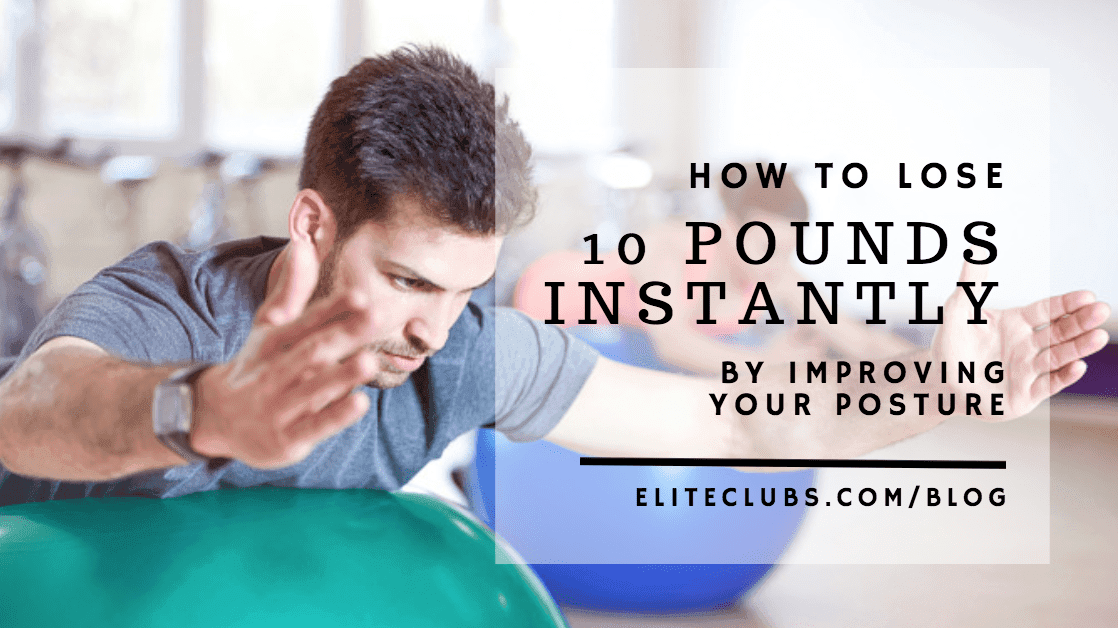
Want to instantly lose 10 pounds? It’s as easy as improving your posture.
Simply by standing up straight, you can look like you’ve lost weight. But for some, standing up straight isn’t that easy! If you slouch or work at a desk round-shouldered day-in and day-out, your body may have adapted to that new position. Fret not, though, there is a fix for this! But before we get into how to fix it, let’s discuss why you need to in the first place.
Appearance
Bad posture can make your midsection look about 2 inches wider, making your clothes fit uncomfortably. And because you are also pushing your gut forward you are creating a potbelly that might not otherwise be there. Think about it: when you are slouching down, you are indeed making yourself shorter, taking your body mass and compressing it into a shorter body. This makes you appear shorter and heavier than you are, with a thicker midsection. What a bummer! No one wants to look fatter than they really are!
Short term and long term damage
If appearance isn’t enough, let’s consider how throwing your body out of alignment affects your health. Lower back pain, shoulder pain, neck pain, tension headaches, and trigger points in your neck and shoulders—even just stiffness and tightness occur due to faulty posture. But even if you don’t have any short term issues, there are long term considerations for bad alignment.
Over time, skeletal damage can occur, as well as disc degeneration and cartilage damage. These contribute to less mobility over time, so years later you are stiff and can’t move around well. That means you are not able to do the things you want to do, because you can’t move well. Is that how you want to feel later in life? Or would you rather be able to do the things you enjoy easily?
Why is our posture so bad?
A number of factors contribute to bad postural alignment. Slumping over a keyboard, slouching while sitting in a chair, driving for long periods, or even being a passenger and sitting for long periods, and what’s now called “text neck” caused by looking down at your phone—all of these daily necessary activities can wreak havoc, causing pain and long term damage.
What can we do about it?
The simplest answer is to make sure you are taking adequate breaks in your day. Get up, stretch, walk around about once an hour if you are a desk jockey. If you’re driving for long periods, stop once in awhile to take a break and walk around to get the blood flowing and give your body a stretch.
There are also exercises that you can do to improve your posture.
- Postural Wall Stand exercise. Put your back against the wall, and press your head, shoulders, and upper back into the wall. Hold for 5 seconds, and then release. Do 5 to start, and build up to 10 reps.
- Postural Wall Slide is another great exercise to counteract bad posture. Standing against a wall, bend at the knees (knees stay behind your toes) into a slight squat. Bring your arms up into a “goal post” next to your ears, then keeping your arms against the wall, bring the arms straight up overhead, and then draw them back to the starting position. Count to 5 as your raise the arms, and count to 5 as you lower to the starting position. Keep them against the wall at all times. Your head stays against the wall as well. Do 5, and work up to 10 reps over the next couple of weeks.
- Prone Back Extension is great for your back strength and posture. Start face down on an exercise ball with your arms stretched out and hands on the floor in front of you—if you need extra support, you can put your feet against a wall—hips and pelvis are on the top of the ball, inhale at the bottom, exhale and lift your arms and head up together. Do 3 sets of 12 repetitions.

Written by Melissa Abramovich, ACE CPT, NASM CGT, AAHFRP Medical Exercise Specialist at Elite Sports Club-River Glen
Melissa Abramovich went into Personal Training and Group Exercise instruction after successfully losing 140 pounds through healthy diet and exercise. Her desire to help others drove her forward into a career helping others to make healthier choices. She is an ACE certified personal trainer and now also a Medical Exercise Specialist (AAHFRP), helping clients with a myriad of health issues at Elite Sports Clubs. She holds a Bachelor’s degree, and many group exercise related certifications as well.